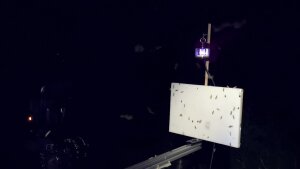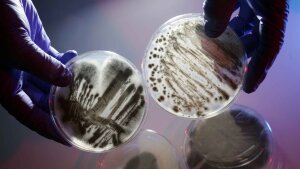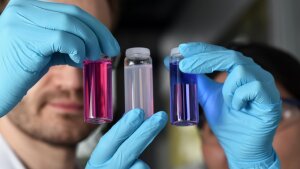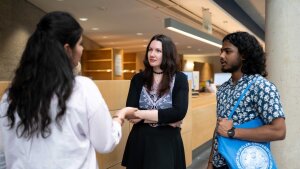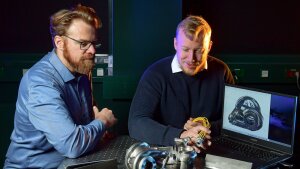New projects
Bringing moths into the light
One of the camera light traps used in the new LEPMON project of the University of Jena and its partners.
Image: Gunnar BrehmFederal Ministry of Education and Research (BMBF) funds moth monitoring project
Germany is home to around 1,160 different species of moths. Researchers are now seeking to establish a nationwide monitoring system as part of a broad-based research project. Light traps with cameras (pictured) are at the heart of the project and will be installed in eight German cities, with five sites in each city.
Dr Gunnar Brehm of the University of Jena is collaborating with research partners in Leipzig, Bonn and other cities. The use of artificial intelligence (AI) is integral to the »LEPMON«External link project to help identify different species. The Federal Ministry of Education and Research (BMBF) will provide almost €1.8 million in funding for the project’s initial three-year term, with field research set to commence in April 2025. [sl]
Processing plastic waste
At the University of Jena, synthesis robots are investigating the recycling of polymers.
Image: Anna SchrollUniversity of Jena and University of Bayreuth launch plastic recycling project with industry partners
In a research project awarded over €1 million by the Federal Ministry of Education and Research (BMBF) as part of its Quantum Systems programme, the University of Jena and the University of Bayreuth have teamed up with the companies BASF, Endress + Hauser Digital Solutions and TechnoCompound GmbH to optimize the plastics recycling process.
The »SpecReK« project aims to precisely and reliably identify the composition of plastic waste during the recycling process with the aim of improving the quality of recycled plastic. Researchers will deploy state-of-the-art spectroscopic methods to determine the plastics, additives and impurities in waste materials in real time. [abu]
»Gender in Focus«
Symbolic image: Pills and tablets lie in and in front of two small glass cups, with the pictograms of a woman and a man in the background.
Image: Jan-Peter Kasper (University of Jena)Launch of project on sex and gender in research
On 29 January 2025, the Thuringian University and State Library hosted a launch event for the »Gender in Focus« project.
The aim of this project, which is funded by the Federal Ministry of Education and Research (BMBF), is to establish sustainable structures for systematic consideration of sex and gender-related aspects in research. Gender-specific differences have often been neglected to date, including in medicine, where such differences can have a decisive impact on the efficacy of drugs and therapies.
This project is one of 12 projects across Germany awarded support through the BMBF’s »Gender Aspects in Focus« (Geschlechteraspekte im Blick) funding line. The Jena-based project prevailed against over 30 submissions in the concept phase, receiving around €850,000 for a fiveyear term. [FB]
New antibiotics
Petri dishes with the fungus Aspergillus fumigatus
Image: Jan-Peter Kasper (University of Jena)Research team develops new strategies to tackle resistant germs
Every year, growing numbers of people die after contracting an infection caused by antibiotic-resistant bacteria. This is because broad-spectrum antibiotics not only eliminate pathogens but also induce resistance, which reduces the efficacy of antibiotics.
A research project at the University of Jena and the Leibniz Institute for Natural Product Research and Infection Biology – Hans Knöll Institute (HKI) has adopted a novel approach to the antibiotics crisis: fighting pathogens by supporting other, non-pathogenic microbes. These beneficial microbes are designed to identify pathogens and render them harmless in a highly specific, localized process.
The »SynThera« project will receive around €5 million of funding from the Carl Zeiss FoundationExternal link over the next five years. [US]
New avenues in nanomedicine
Hands wearing blue rubber gloves present three test tubes with different coloured contents (functionalized polymer nanoparticles).
Image: Anne Günther (University of Jena)Carl Zeiss Foundation supports joint project between University of Mainz and University of Jena
The »Nano@Liver« project aims to use nanoparticles (pictured) to transport active ingredients precisely into different liver cells. This approach is intended to make liver diseases treatable and better control immune response in the liver during treatment. The Carl Zeiss FoundationExternal link has allocated around €6 million to support the project for five years through its »Breakthroughs« programme.
The project aims to research means of modifying nanoparticles to transport drugs to specific types of liver cells. This would open the door to more targeted treatment of liver diseases such as fibrosis, inflammation and tumours. In addition to the targeted release of active agents, the research team also plans to deploy artificial intelligence tools. [Dillinger-Reiter]
Skilled workers for Thuringia
Students in the foyer of the Thuringian University and State Library (ThULB)
Image: Christoph Worsch (University of Jena)Project explores how to attract international students to supplement the state’s labour market
In Thuringia, 386,000 employees are set to retire by 2035. Given the limited availability of workers within the state, around half of these posts are set to remain unfilled. International students (pictured), who could be attracted to work in Thuringia after completing their studies, are therefore the subject of increased attention. The »ARAPiS« project has been launched at the University of Jena in an effort to tap into this potential.
The Thuringian Ministry for Economic Affairs, Science and Digital Society (TMWWDG) is supporting »ARAPiS« with €200,000. At the end of the two-year project term, researchers hope to issue a compact series of recommendations for companies, students and Thuringian universities. [sl]
»3D-Vens«
Dr Andreas Stark from the Institute of Applied Optics and Biophysics with an experimental setup from the 3D-Vens project.
Image: Jürgen Scheere (University of Jena)Research team targets explosion-proof 3D endoscope
Many hopes have been pinned on green hydrogen for climate-neutral energy and heat generation and as a fuel of the future. However, hydrogen-based technologies entail considerable risks: when hydrogen comes into contact with air, it forms an explosive mixture. Even the tiniest sparks can trigger explosions. This is currently a significant limiting factor on the use of hydrogen.
A team at the University of Jena, the Fraunhofer Institute of Applied Optics and Precision Engineering and three industry partners, led by Dr Andreas Stark (pictured) has set about making the measurement technology needed to inspect and maintain hydrogen tanks and pipes safe enough to eliminate the risk of sparks. The »3D-Vens« project has been awarded €3 million of funding by the Federal Ministry of Education and Research (BMBF). [US]
»LignUp«
Symbolic image: Felled trees lie on the forest floor in the Stadtroda forest in the Saale-Holzland district.
Image: Jan-Peter Kasper (University of Jena)Building and recycling sustainable batteries from wood waste
Trees contain high levels of a biopolymer called lignin, which gives wood its enduring stability. When paper producers process wood, their interest is limited to its cellulose content. The lignin, which is left over, accounts for almost half of the wood’s mass.
In the collaborative »LignUp« project, researchers at the Center for Energy and Environmental Chemistry (CEEC Jena) have committed to transforming lignin from a waste product into a valuable resource. More specifically, the researchers are using lignin as the starting material for functional materials to help improve the sustainability of energy storage systems by removing the need for rare metals like lithium, cobalt and manganese.
The project will receive almost €5 million from the Carl Zeiss Foundation over a six-year term as part of its »Breakthrough« programmeExternal link. [US]
